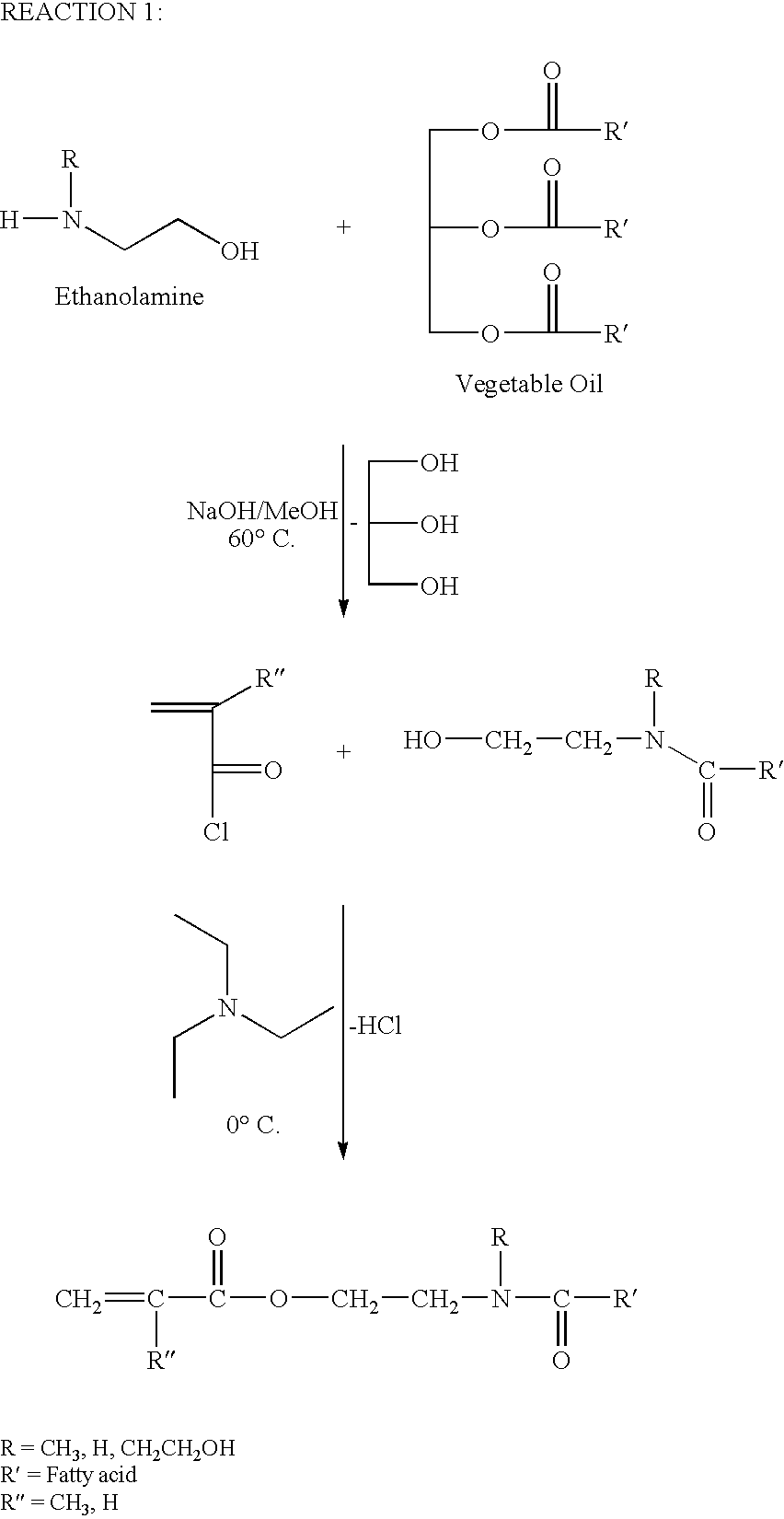Glycerol Ester-Free Functionalized Vegetable Oil Derivatives and Their Latex Compounds
a technology functionalized vegetable oil, which is applied in the field of vegetable oil derivatives, can solve the problems of low development rate of coating formulations, reduced long-term storage stability of monomers and polymers, and inability to use coatings
- Summary
- Abstract
- Description
- Claims
- Application Information
AI Technical Summary
Benefits of technology
Problems solved by technology
Method used
Image
Examples
example 1
SoyA-1
[0020]A three-neck, 1000 mL round bottom flask was purged with nitrogen once equipped with mechanical stirrer, thermometer, condenser and was charged with 500 g soybean oil. Nitrogen was bubbled through the oil overnight to deoxygenate the oil. The flask was placed in an oil bath at 80° C., and 50 g of a sodium methoxide methanol solution (25% in methanol) was added to the flask. The reaction mixture was equilibrated to 80° C., and 125.46 g of N-methyl ethanolamine was added to the flask. An exotherm of approximately 10° C. was noted. The reaction was maintained and the reaction progress was monitored by Fourier transform infrared spectroscopy (FTIR). Complete conversion via FTIR was observed after 4 hours. The reactor was cooled to ambient conditions and diluted with 100 g of methylene chloride. The contents were washed three times with 500 mL of brine (5% sodium chloride). The aqueous phase was discarded and the organic phase was dried with magnesium sulfate. Methylene chlor...
example 2
SoyA-2
[0021]A three-neck, 1000 mL round bottom flask was purged with nitrogen once equipped with mechanical stirrer, thermometer, condenser and was charged with 500 g soybean oil. Nitrogen was bubbled into the mixture overnight to deoxygenate the oil. The flask was placed in an oil bath at 80° C., and 50 g of a sodium methoxide methanol solution (25% in methanol) was added to the flask. The reaction mixture was equilibrated to 80° C., and 186.05 g of ethanolamine was added to the flask. An exotherm of approximately 10° C. was noted. The reaction was maintained and the reaction progress was monitored by Fourier transform infrared spectroscopy (FTIR). Complete conversion via FTIR was observed after 4 hours. The reactor was cooled to ambient conditions and diluted with 100 g of methylene chloride. The contents were washed three times with 500 mL of brine (5% sodium chloride). The aqueous phase was discarded and the organic phase was dried with magnesium sulfate. Methylene chloride was ...
example 3
SoyAA-1
[0022]A three-neck, 1000 mL round bottom flask equipped with thermometer, mechanical stirrer, and addition funnel was charged with 250.00 g of SoyA-1, 100.00 mL of methylene chloride, and 74.94 g of triethylamine. The flask was placed in an ice bath and equilibrated to 0° C. 70.00 g of acryloyl chloride was charged to the addition funnel, and added dropwise into the flask over 4 hours. The flask was allowed to equilibrate to ambient conditions overnight. The contents were washed 5 times with 500 mL of brine (5% sodium chloride) to remove unreacted acryloyl chloride, triethylamine, and hydrochloric acid. The aqueous phase was discarded and the organic phase was dried with magnesium sulfate. Methylene chloride was removed under reduced pressure, and the product (SoyAA-1) was characterized by GPC, HPLC, and NMR spectroscopy.
PUM
| Property | Measurement | Unit |
|---|---|---|
| temperature | aaaaa | aaaaa |
| glass transition temperature | aaaaa | aaaaa |
| Tg | aaaaa | aaaaa |
Abstract
Description
Claims
Application Information
 Login to View More
Login to View More - R&D
- Intellectual Property
- Life Sciences
- Materials
- Tech Scout
- Unparalleled Data Quality
- Higher Quality Content
- 60% Fewer Hallucinations
Browse by: Latest US Patents, China's latest patents, Technical Efficacy Thesaurus, Application Domain, Technology Topic, Popular Technical Reports.
© 2025 PatSnap. All rights reserved.Legal|Privacy policy|Modern Slavery Act Transparency Statement|Sitemap|About US| Contact US: help@patsnap.com



